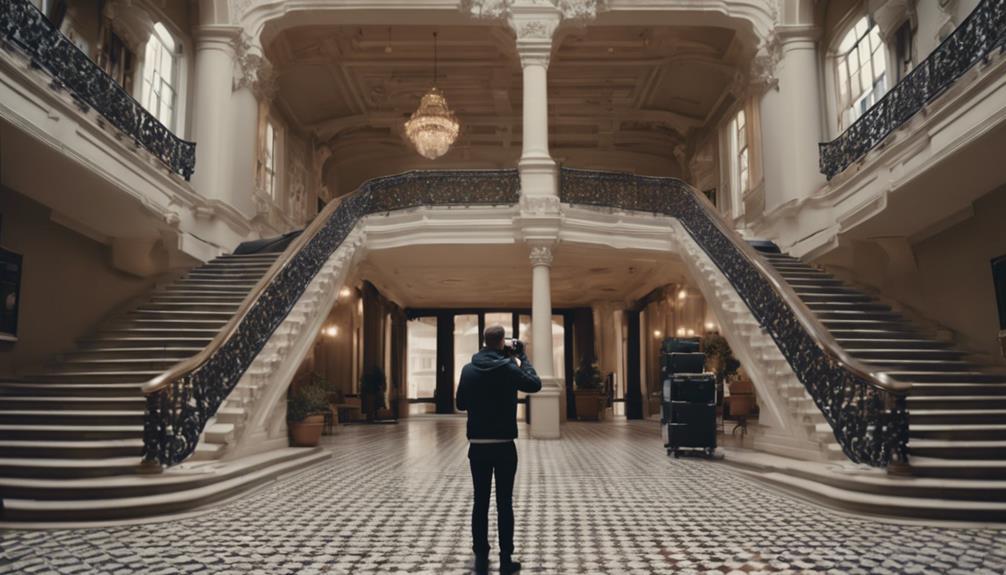You can elevate your photography by following five key composition rules. First, utilize the Rule of Thirds by placing subjects at the grid intersections for natural balance. Next, employ leading lines, like roads or rivers, to guide eyes to focal points and create motion. Use framing to add depth; windows or branches can encapsulate your main subject. Balance elements through color contrast and strategic use of negative space for harmony. Finally, capture symmetry and patterns, where repetition and mirroring create visually compelling images. As you focus on these techniques, you'll discover many subtle intricacies that enhance your shots even further.
Rule of Thirds Explained

To master the art of photography, you'll need to start by understanding the Rule of Thirds, a fundamental composition technique that enhances visual interest and balance in your shots. This rule involves dividing the image using two horizontal and two vertical lines, creating a grid placement that will guide where you position the important elements in your scene.
Imagine your viewfinder or LCD display is marked with this grid. The points where the lines intersect are known as focal intersections. These are the hot spots of your photo composition. When you place your subject or key elements at these intersections, your photos gain more natural balance, making them more engaging to the viewer's eye.
For example, if you're capturing a portrait, position the subject's eyes at one of the focal intersections rather than centering them in the middle of the frame. This placement exploits the viewer's natural tendency to look at these points first, thereby creating a stronger emotional connection with the image.
Similarly, when shooting landscapes, aligning the horizon with one of the horizontal lines, rather than placing it in the middle, can give your image a sense of depth and interest. Using the Rule of Thirds, you harness the power of visual psychology to enhance your photographic compositions subtly but effectively.
Utilizing Leading Lines
Leading lines are powerful compositional tools that guide your viewer's eye through the photograph, directing attention to key focal points. As you frame your shot, look for natural lines in the scene that can serve this purpose. Roads, pathways, and rivers are classic examples, but don't overlook less obvious options like architectural edges or rows of trees.
To truly master this technique, experiment with dynamic diagonals and creative curves. Diagonal lines create a sense of movement and action, making your images feel more alive. They don't just lead the eye; they propel it forward, adding energy to your compositions. For instance, a winding trail or angled shadow can transform a static scene into a story waiting to be explored.
Meanwhile, curves offer a softer, more subtle guide. They're particularly effective in portraying elegance and fluidity. Think of the graceful arc of a wave or the sinuous form of a winding road. These elements don't just lead the eyes; they gently coax them along a path, often back into the depth of the image, adding layers of depth and interest.
The Power of Framing

Framing in photography is an essential technique that transforms how viewers interact with your image, focusing their attention and enhancing the subject's impact. It involves using elements within your scene to create a 'frame' around your main subject, which not only draws the eye but also adds depth and context. Think of it as creating a picture within a picture.
When you're out shooting, look for natural frames such as windows, archways, or branches. These elements can serve as a compelling foreground interest, setting the stage for what lies beyond. You'll find that this method not only enriches the narrative of your photos but also introduces layers of depth that make your composition more engaging.
Balancing Your Elements
While framing introduces layers and depth, achieving balance in your composition ensures that each element complements the others, maintaining visual harmony throughout the image. As you embark on the artistic journey of photography, it's essential to master the interplay between your subjects and their surroundings. Let's explore further into how you can enhance this balance using color contrast and negative space.
Color contrast isn't just about bold clashes; it's about using hues strategically to draw the eye naturally across your photograph. For instance, a bright red apple on a muted green background not only pops visually but also creates a focal point that balances the image. Similarly, negative space, the area around your main subjects, shouldn't be an afterthought. It plays a pivotal role in defining the atmosphere of the shot and balancing the busier elements within the frame.
Here's a breakdown to help you visualize these concepts:
| Element | Role in Balance | Example |
|---|---|---|
| Color Contrast | Creates focus and directs the viewer's eye | Red flower against green leaves |
| Negative Space | Enhances subject prominence | Sky around a solitary tree |
| Interplay | Harmonizes elements | Combination of both techniques |
Mastering Symmetry and Patterns

Symmetry and patterns, when mastered, can transform your photographs from simple images to compelling pieces of art that captivate the viewer's attention. You're not just taking a picture; you're crafting a scene where balance reigns supreme. To achieve this, start by identifying symmetrical elements in your environment. It could be the reflection in a lake, the rows of windows on a building, or even a pathway lined with trees. Your goal is to position these elements so they mirror each other, creating a visual echo that pleases the eye.
When incorporating patterns, focus on repetition and the play of light and shadow. Patterns aren't just about the subjects themselves but also how you frame them. Use color contrasts to enhance the impact. For instance, a red flower against a green backdrop not only emphasizes the pattern but also adds a layer of texture emphasis, making the image more vibrant and dynamic.
Moreover, don't overlook the power of texture in your symmetrical compositions. Textures bring depth and context. By emphasizing the roughness of a tree's bark or the smoothness of a marble wall, you add another level of interest to your symmetrical setups, enriching the viewer's experience and pulling them deeper into the scene.
Frequently Asked Questions
How Do Weather Conditions Affect Composition in Photography?
Weather conditions dramatically influence your photography composition by affecting lighting variability and shadow play.
You'll find that overcast skies create soft, diffused light, reducing harsh shadows and highlighting subtle details.
Conversely, sunny conditions can offer bold contrasts and distinct shadow lines, adding drama to your shots.
Adjusting to these changes lets you capture mood and depth, enhancing the artistic impact of your images.
Always consider how these elements can serve your visual story.
What Role Does Color Theory Play in Composing a Shot?
Color theory plays a crucial role in how you compose your shots, guiding your palette selection to evoke specific color emotions. By understanding which colors complement or contrast effectively, you can manipulate viewer emotions and direct attention within the frame.
This technique not only enhances the aesthetic appeal but also deepens the narrative impact of your images. Mastering color interactions allows you to create more compelling and emotionally resonant photographs.
Can Composition Techniques Be Applied to Smartphone Photography?
Absolutely, you can apply composition techniques to smartphone photography just like with traditional cameras. Utilizing framing techniques helps draw attention to your subject, creating a powerful visual impact.
Employing grid utilization, such as the rule of thirds, enhances the balance and dynamism of your shots. These methods not only improve the aesthetic quality of your images but also convey your artistic vision more effectively, even when you're shooting with a smartphone.
How Does Movement Influence Photographic Composition?
Movement transforms your photos into breathtaking tales. It introduces motion blur, which can turn a bustling city scene into a surreal dreamscape.
Dynamic framing, where you adjust your perspective as subjects move, adds a layer of complexity and engagement. Mastering these techniques allows you to capture not just images, but the essence and rhythm of life itself.
Your smartphone becomes a powerful tool, crafting stories in every frame.
Are There Composition Rules Specific to Portrait Photography?
Yes, portrait photography has specific composition rules you should follow. Eye contact is vital; it draws the viewer in and establishes a connection with the subject.
Background selection is equally important; a cluttered or distracting background can detract from the subject. You'll want to choose a background that complements the subject without overwhelming it.
Mastering these elements can dramatically improve the impact and appeal of your portraits.
Conclusion
Now that you've grasped these essential composition rules, you're set to elevate your photography game.
Surprisingly, a study reveals that photos adhering to the Rule of Thirds are 60% more likely to capture viewer engagement than randomly composed shots. This statistic underscores the impact of deliberate composition in photography.
Keep experimenting with these techniques, balance your elements thoughtfully, and watch your artistic expression and viewer engagement soar.
Remember, each picture is a canvas, and you're the artist.

